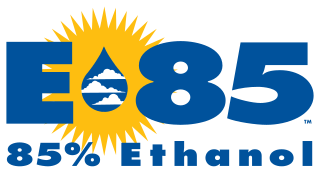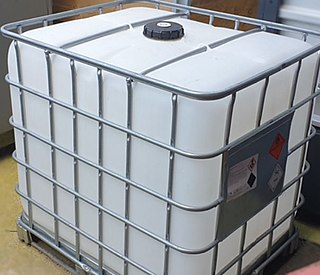Related Research Articles

Ethanol fuel is fuel containing ethyl alcohol, the same type of alcohol as found in alcoholic beverages. It is most often used as a motor fuel, mainly as a biofuel additive for gasoline.

Liquid fuels are combustible or energy-generating molecules that can be harnessed to create mechanical energy, usually producing kinetic energy; they also must take the shape of their container. It is the fumes of liquid fuels that are flammable instead of the fluid. Most liquid fuels in widespread use are derived from fossil fuels; however, there are several types, such as hydrogen fuel, ethanol, and biodiesel, which are also categorized as a liquid fuel. Many liquid fuels play a primary role in transportation and the economy.
Methanol fuel is an alternative biofuel for internal combustion and other engines, either in combination with gasoline or independently. Methanol (CH3OH) is less expensive to produce sustainably than ethanol fuel, although it produces more toxic effects than ethanol and has lower energy density than gasoline. Methanol is safer for the environment than gasoline, is an anti-freeze agent, prevents dirt and grime buildup within the engine, has a higher flashpoint in case of fire, and produces horsepower equivalent to that of super high-octane gasoline. It can readily be used in most modern engines with a simple software setting tweak and occasionally a change in a cheap fuel seal or line. To prevent vapor lock in any possible circumstances due to being a simple, pure fuel, a small percentage of other fuel or certain additives can be included. Methanol (a methyl group linked to a hydroxyl group) may be made from fossil fuels or renewable resources, in particular natural gas and coal, or biomass respectively. In the case of the latter, it can be synthesized from CO2 (carbon dioxide) and hydrogen. The vast majority of methanol produced globally is currently made with gas and coal. However, projects, investments, and the production of green-methanol has risen steadily into 2023. Methanol fuel is currently used by racing cars in many countries and has seen increasing adoption by the maritime industry.

A Natural Gas Vehicle (NGV) is an alternative fuel vehicle that uses compressed natural gas (CNG) or liquefied natural gas (LNG). Natural gas vehicles should not be confused with autogas vehicles powered by liquefied petroleum gas (LPG), mainly propane, a fuel with a fundamentally different composition.

William Clay Ford Jr. is an American businessman, serving as executive chairman of Ford Motor Company. The great-grandson of company founder Henry Ford, Ford joined the board in 1988 and has served as chairman since January 1999. Ford also served as the president, CEO, and COO until turning over those roles to former Boeing executive Alan Mulally in September 2006. Ford is also the vice chairman of the Detroit Lions NFL franchise. Ford serves as a chairman of the United States-Mexico Chamber of Commerce.

E85 is an abbreviation typically referring to an ethanol fuel blend of 85% ethanol fuel and 15% gasoline or other hydrocarbon by volume.

The methanol economy is a suggested future economy in which methanol and dimethyl ether replace fossil fuels as a means of energy storage, ground transportation fuel, and raw material for synthetic hydrocarbons and their products. It offers an alternative to the proposed hydrogen economy or ethanol economy, although these concepts are not exclusive. Methanol can be produced from a variety of sources including fossil fuels as well as agricultural products and municipal waste, wood and varied biomass. It can also be made from chemical recycling of carbon dioxide.

A flexible-fuel vehicle (FFV) or dual-fuel vehicle is an alternative fuel vehicle with an internal combustion engine designed to run on more than one fuel, usually gasoline blended with either ethanol or methanol fuel, and both fuels are stored in the same common tank. Modern flex-fuel engines are capable of burning any proportion of the resulting blend in the combustion chamber as fuel injection and spark timing are adjusted automatically according to the actual blend detected by a fuel composition sensor. This device is known as an oxygen sensor and it reads the oxygen levels in the stream of exhaust gasses, its signal enriching or leaning the fuel mixture going into the engine. Flex-fuel vehicles are distinguished from bi-fuel vehicles, where two fuels are stored in separate tanks and the engine runs on one fuel at a time, for example, compressed natural gas (CNG), liquefied petroleum gas (LPG), or hydrogen.

Several common ethanol fuel mixtures are in use around the world. The use of pure hydrous or anhydrous ethanol in internal combustion engines (ICEs) is only possible if the engines are designed or modified for that purpose, and used only in automobiles, light-duty trucks and motorcycles. Anhydrous ethanol can be blended with gasoline (petrol) for use in gasoline engines, but with high ethanol content only after engine modifications to meter increased fuel volume since pure ethanol contains only 2/3 of the BTUs of an equivalent volume of pure gasoline. High percentage ethanol mixtures are used in some racing engine applications as the very high octane rating of ethanol is compatible with very high compression ratios.

Various alcohols are used as fuel for internal combustion engines. The first four aliphatic alcohols are of interest as fuels because they can be synthesized chemically or biologically, and they have characteristics which allow them to be used in internal combustion engines. The general chemical formula for alcohol fuel is CnH2n+1OH.
The United States produces mainly biodiesel and ethanol fuel, which uses corn as the main feedstock. The US is the world's largest producer of ethanol, having produced nearly 16 billion gallons in 2017 alone. The United States, together with Brazil accounted for 85 percent of all ethanol production, with total world production of 27.05 billion gallons. Biodiesel is commercially available in most oilseed-producing states. As of 2005, it was somewhat more expensive than fossil diesel, though it is still commonly produced in relatively small quantities.
E85 is an abbreviation for an ethanol fuel blend of between 51% and 83% denatured ethanol fuel and gasoline or other hydrocarbon (HC) by volume.

Butanol may be used as a fuel in an internal combustion engine. It is more similar to gasoline than it is to ethanol. A C4-hydrocarbon, butanol is a drop-in fuel and thus works in vehicles designed for use with gasoline without modification. Both n-butanol and isobutanol have been studied as possible fuels. Both can be produced from biomass (as "biobutanol" ) as well as from fossil fuels (as "petrobutanol"). The chemical properties depend on the isomer (n-butanol or isobutanol), not on the production method.

An alternative fuel vehicle is a motor vehicle that runs on alternative fuel rather than traditional petroleum fuels. The term also refers to any technology powering an engine that does not solely involve petroleum. Because of a combination of factors, such as environmental and health concerns including climate change and air pollution, high oil-prices and the potential for peak oil, development of cleaner alternative fuels and advanced power systems for vehicles has become a high priority for many governments and vehicle manufacturers around the world.

Corn ethanol is ethanol produced from corn biomass and is the main source of ethanol fuel in the United States, mandated to be blended with gasoline in the Renewable Fuel Standard. Corn ethanol is produced by ethanol fermentation and distillation. It is debatable whether the production and use of corn ethanol results in lower greenhouse gas emissions than gasoline. Approximately 45% of U.S. corn croplands are used for ethanol production.

Biofuels are renewable fuels that are produced by living organisms (biomass). Biofuels can be solid, gaseous or liquid, which comes in two forms: ethanol and biodiesel and often replace fossil fuels. Many countries now use biofuels as energy sources, including Sweden. Sweden has one of the highest usages of biofuel in all of Europe, at 32%, primarily due to the widespread commitment to E85, bioheating and bioelectricity.

Bi-fuel vehicles are vehicles with multifuel engines capable of running on two fuels. The two fuels are stored in separate tanks and the engine is able to run on one fuel at a time. On internal combustion engines, a bi-fuel engine typically burns gasoline and a volatile alternate fuel such as natural gas (CNG), LPG, or hydrogen. Bi-fuel vehicles have the capability to switch back and forth from the gasoline to the other fuel, manually or automatically. A related concept is the duel-fuel vehicle which must burn both fuels in combination. Diesel engines converted to use gaseous fuels fall into this class due to the different ignition system.
The fleet of flexible-fuel vehicles in the United States is the second largest in the world after Brazil, and there were more than 21 million 85 flex-fuel vehicles registered in the country by the end of 2017. Despite the growing fleet of E85 flex-fuel vehicles, actual use of ethanol fuel is limited due to the lack of E85 refueling infrastructure and also because many North American flex-fuel car owners were not aware they owned an E85 flex-fuel vehicle. Flex-fuel vehicles are common in the Midwest, where corn is a major crop and is the primary feedstock for ethanol fuel production. Also the U.S. government has been using flex-fuel vehicles for many years.
The Open Fuel Standard Coalition is a bipartisan group in the United States actively working for passage of H.R. 1687, the "Open Fuel Standard Act of 2011." The OFS Coalition views this legislation as the solution to the current energy crisis by the implementing of alternative energy sources into our fuel transportation market sector, thereby breaking our dependence on foreign oil. Specifically, by implementing H.R. 1687, the Open Fuel Standard Act of 2011 all vehicles sold in the US will have to either operate on mixed fuels, containing 85 percent ethanol, methanol, biodiesel, or any other alternative energy source.
Pearson Fuels is a privately held alternative fuel retailer founded in San Diego in 2002. Pearson Fuels is notable as the first alternative fuel station in the United States to offer alternate vehicle fuels including ethanol, biodiesel, compressed natural gas (CNG), propane, hydrogen, and electric vehicle charging. Pearson Fuels is headquartered in San Diego.
References
- ↑ "Methanol (M85)". www.altfuels.org. Retrieved 2023-11-10.
- ↑ Rapier, Robert (2006-06-02). "E85, M85, or Gasoline?". Energy Trends Insider. Archived from the original on 2015-06-08. Retrieved 2015-06-08.